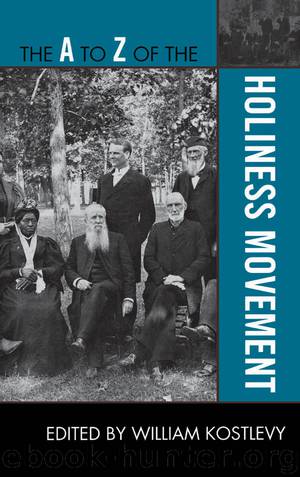The A to Z of the Holiness Movement by William Kostlevy

Author:William Kostlevy
Language: eng
Format: epub
Publisher: Scarecrow Press
Published: 2009-04-12T04:00:00+00:00
– K –
KEEN, SAMUEL ASHTON (b. Harrison, Ohio, 12 May 1842; d. Delaware, Ohio, 11 November 1895). Methodist Episcopal Church (MEC) minister, evangelist, and author. Following three years of service with the Union Army in the Civil War, Keen enrolled at Ohio Wesleyan University. Following his graduation in 1868, he entered the Ohio Conference of the MEC. Experiencing entire sanctification in 1869 during his first pastorate in Chillicothe, Keen established a reputation as an effective pastor and skilled evangelist. Following pastorates in Ohio and Indiana, Keen entered full-time evangelistic work in 1891. Perhaps the most notable feature of his evangelistic career was the so-called Pentecostal meetings he conducted during regular sessions of many annual conferences. Instituted by Bishop I. W. Joyce, these meetings were the primary source of Holiness agitation in the MEC during the last decade of the 19th century. Keen was a frequent contributor to a variety of religious periodicals and wrote several books, including Praise Papers: A Spiritual Autobiography (1895). Following his death, his widow, Mary Keen, prepared a biography, Memorial Papers, or Records of a Spirit-Filled Life (1899), based on his letters and journals. W.C.K.
KENT, LYMAN BLAKEMARR (b. Wyoming County, New York, 2 July 1830; d. Jacksonville, Illinois, 24 May 1911). Methodist Episcopal Church (MEC) and Pentecostal Church of the Nazarene (PCN; see CHURCH OF THE NAZARENE) minister, evangelist, and editor. Converted in 1847, Kent entered the ministry of the MEC in 1849 in the Northern Indiana Conference. After serving circuits in such Indiana communities as Valparaiso, Laporte, Rochester, and New Carlisle, Kent transferred to the Central Illinois Conference in 1859. Following pastorates in Galesburg and Rock Island, he was appointed presiding elder of the Peoria District in 1866. He later served as pastor of congregations in Macomb and Lacon. In 1871, he was one of the founders of the Western Union Holiness Association (WUHA), known after 1898 as the Illinois Holiness Association (IHA). In 1878, as Holiness agitation in the conference became increasingly controversial, he was denied an appointment. Beginning a full-time ministry in evangelism, Kent became one of the Midwest’s most notable Holiness evangelists. He served as president of the WUHA/IHA (1872–1906) and as editor of its periodical, the Banner of Holiness (1883–1890). Although highly critical of the MEC, Kent opposed the formation of distinctly Holiness churches. He remained convinced that the experience of full salvation was not the unique property of any sect or denomination. In spite of these convictions, by the time of his death, he had affiliated with the PCN. Following his death, Bertha Corson and Iva Durham Vennard edited his journals, correspondence, and writings into a biography, A Stalwart of the Old Guard: The Life and Labors of Lyman Blackmarr Kent (1911). W.C.K.
KENTUCKY MOUNTAIN HOLINESS ASSOCIATION. See McCONNELL, LELA GRACE.
KESWICK. A specific teaching on entire sanctification, or, as its proponents prefer, “the higher Christian life”; an annual convention held at Keswick, England; and related conventions held around the world. The term’s origins lie in a series of “higher life meetings” held by Robert P.
Download
This site does not store any files on its server. We only index and link to content provided by other sites. Please contact the content providers to delete copyright contents if any and email us, we'll remove relevant links or contents immediately.
The Gnostic Gospels by Pagels Elaine(2468)
Jesus by Paul Johnson(2309)
Devil, The by Almond Philip C(2280)
The Nativity by Geza Vermes(2179)
The Psychedelic Gospels: The Secret History of Hallucinogens in Christianity by Jerry B. Brown(2121)
Forensics by Val McDermid(2042)
Going Clear: Scientology, Hollywood, and the Prison of Belief by Lawrence Wright(1935)
Going Clear by Lawrence Wright(1921)
Barking to the Choir by Gregory Boyle(1786)
Old Testament History by John H. Sailhamer(1768)
Augustine: Conversions to Confessions by Robin Lane Fox(1736)
The Early Centuries - Byzantium 01 by John Julius Norwich(1699)
A History of the Franks by Gregory of Tours(1682)
A Prophet with Honor by William C. Martin(1682)
Dark Mysteries of the Vatican by H. Paul Jeffers(1673)
The Bible Doesn't Say That by Dr. Joel M. Hoffman(1652)
by Christianity & Islam(1594)
The First Crusade by Thomas Asbridge(1575)
The Amish by Steven M. Nolt(1530)
